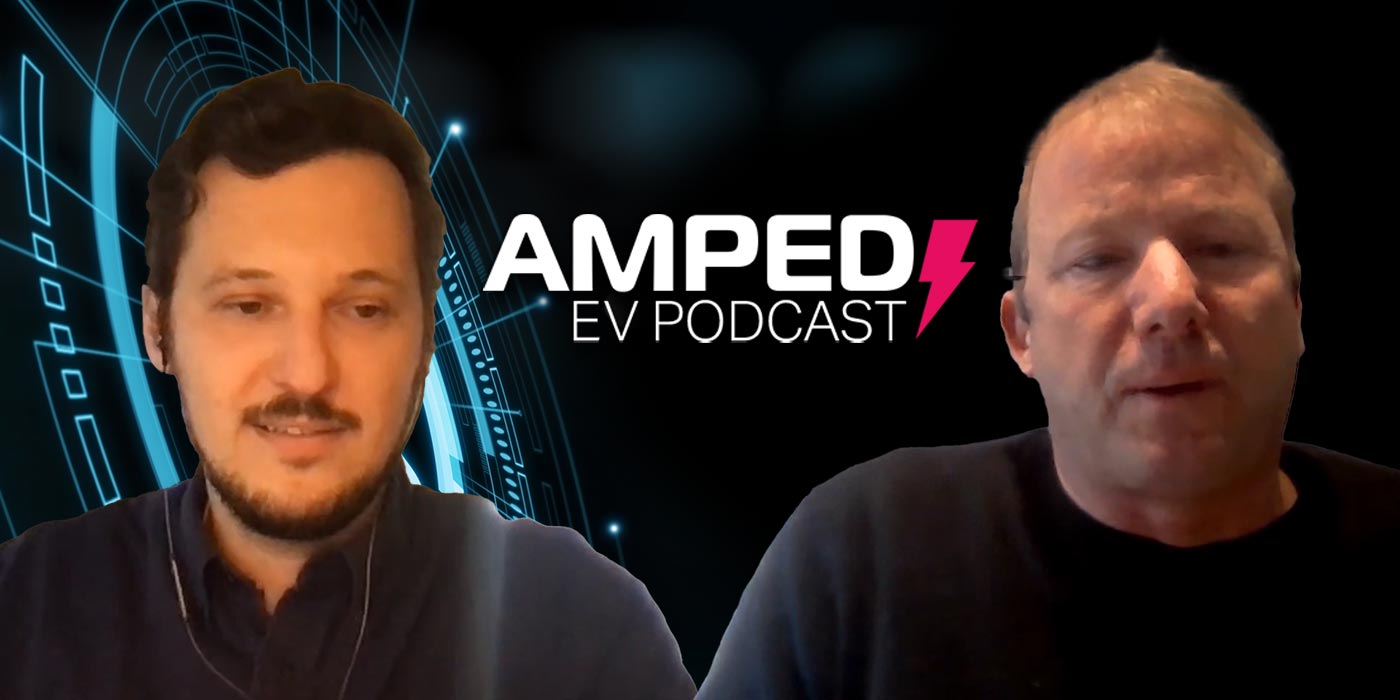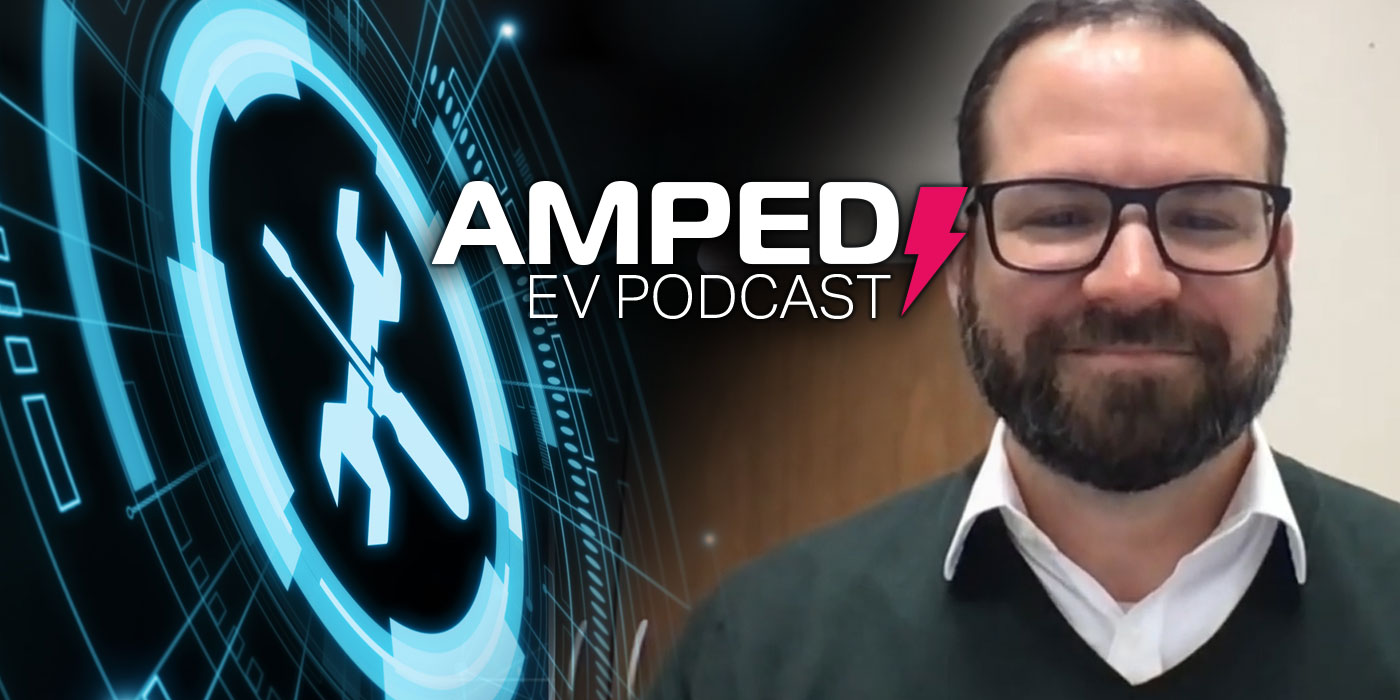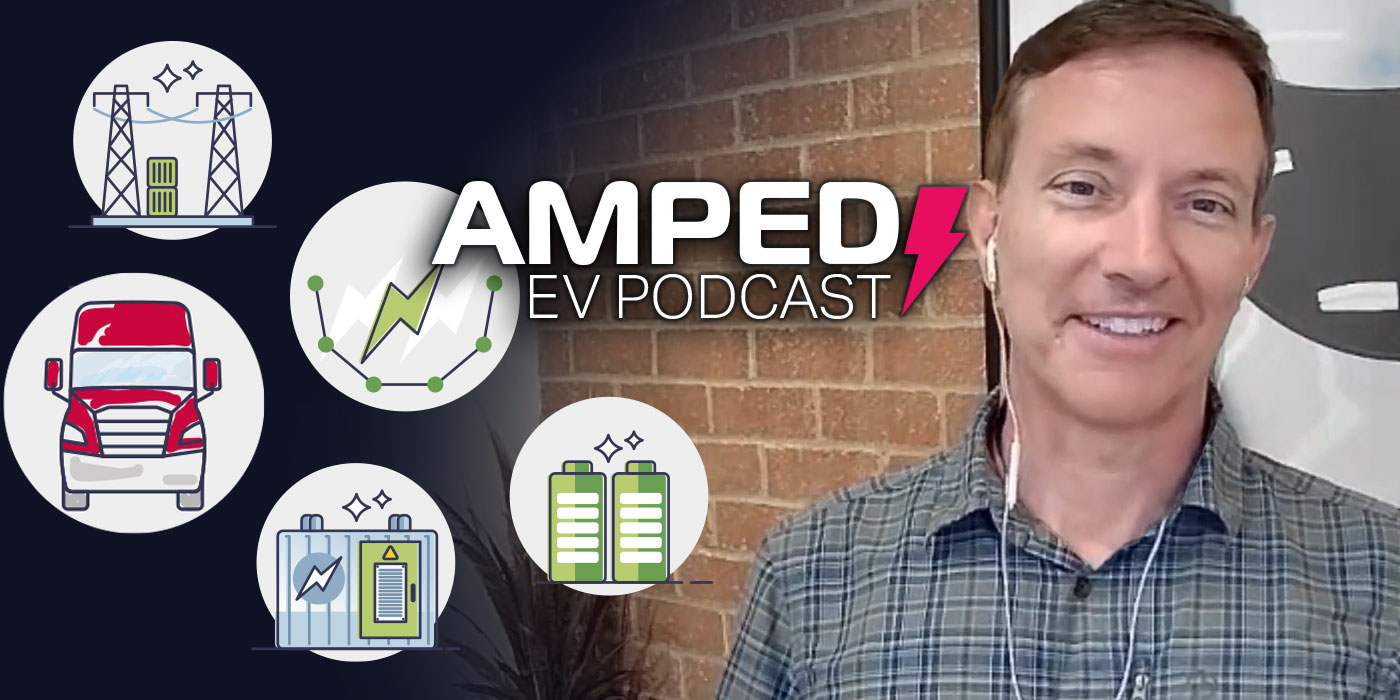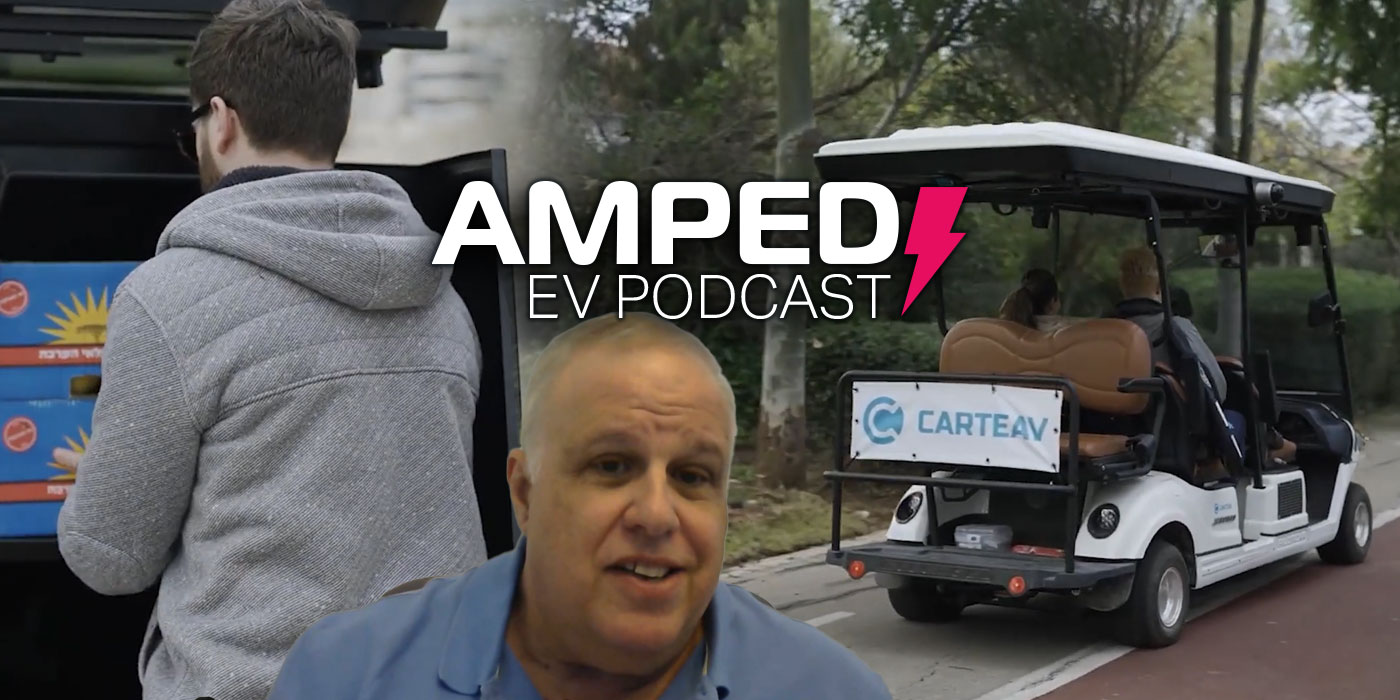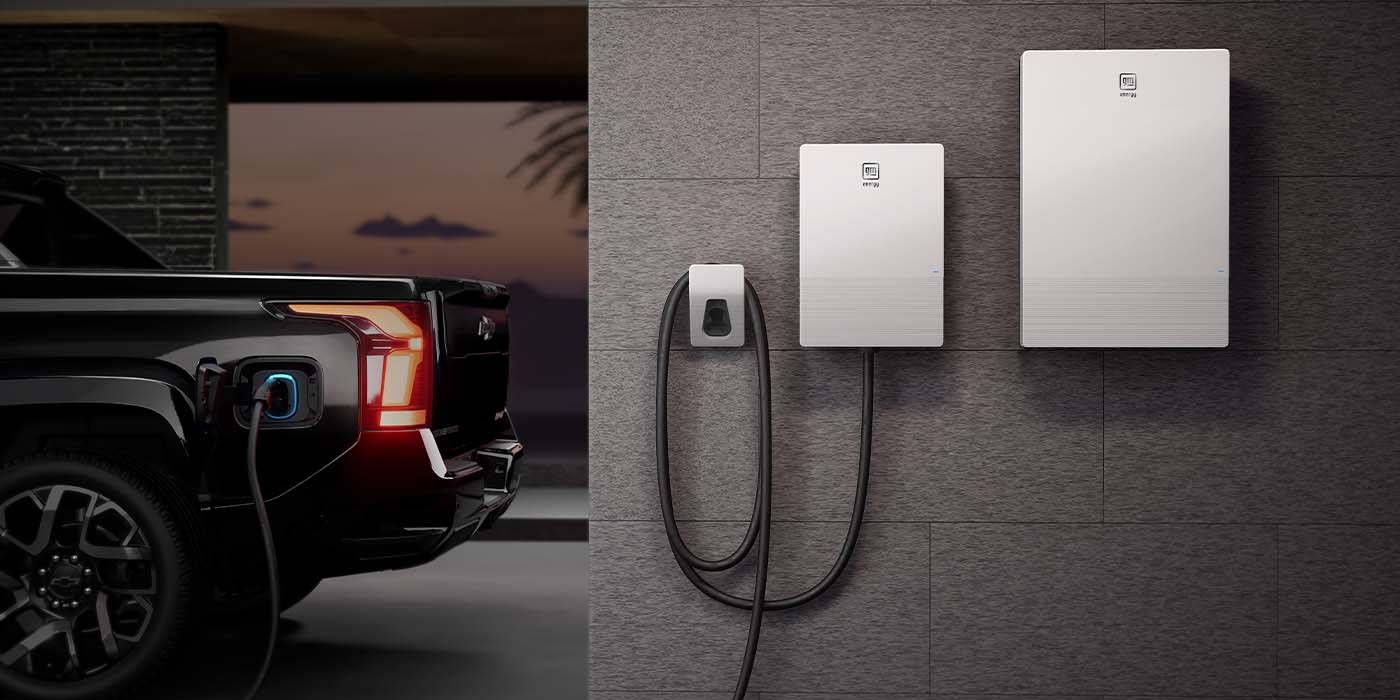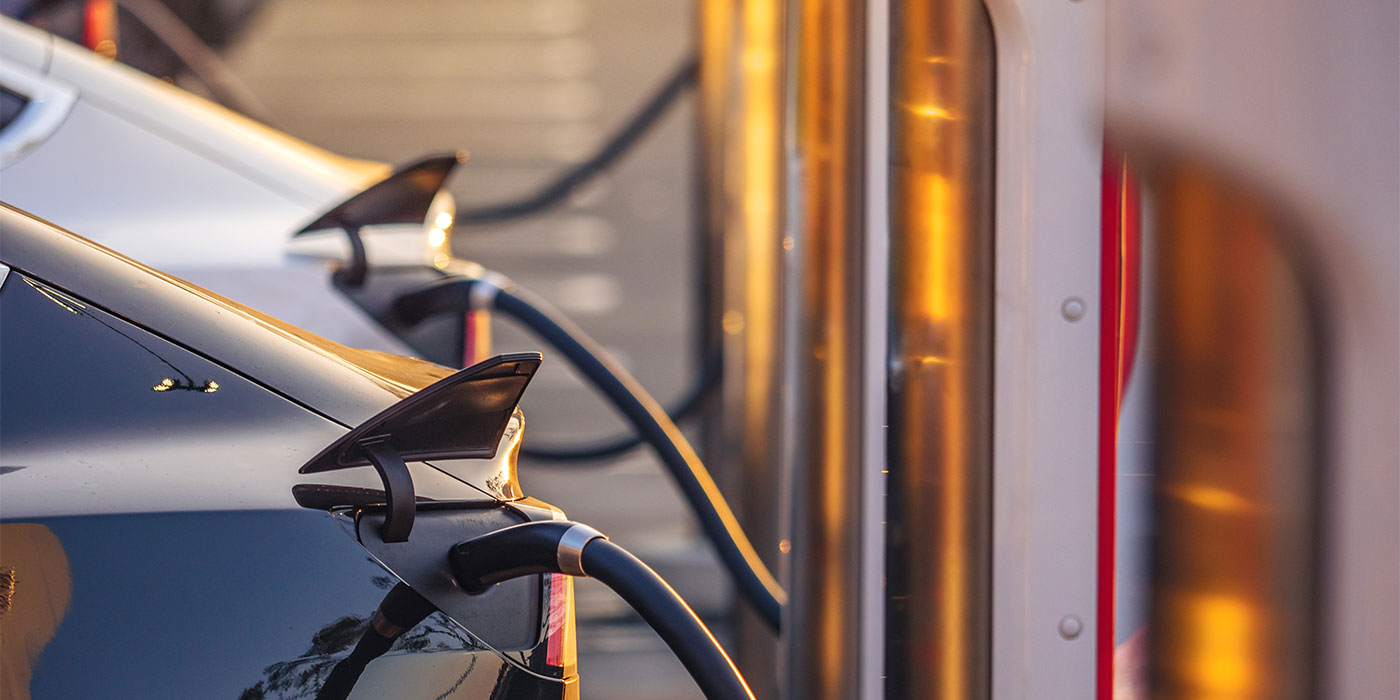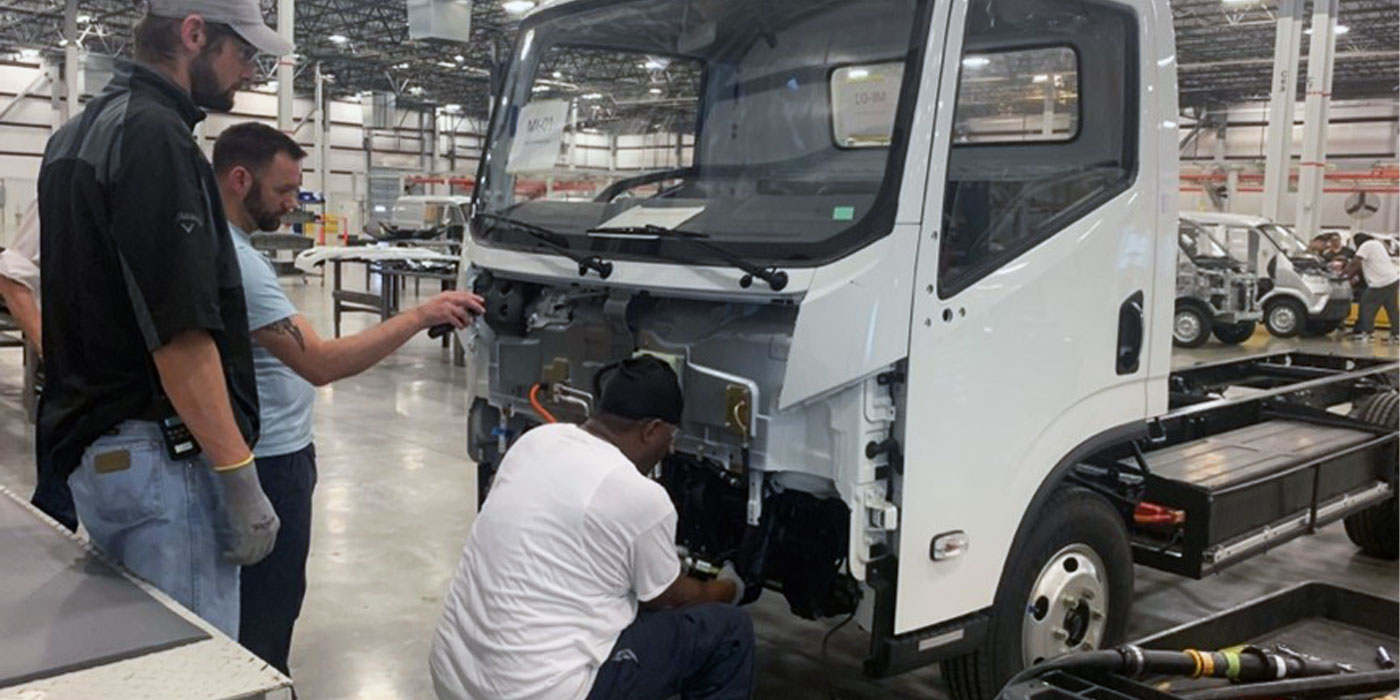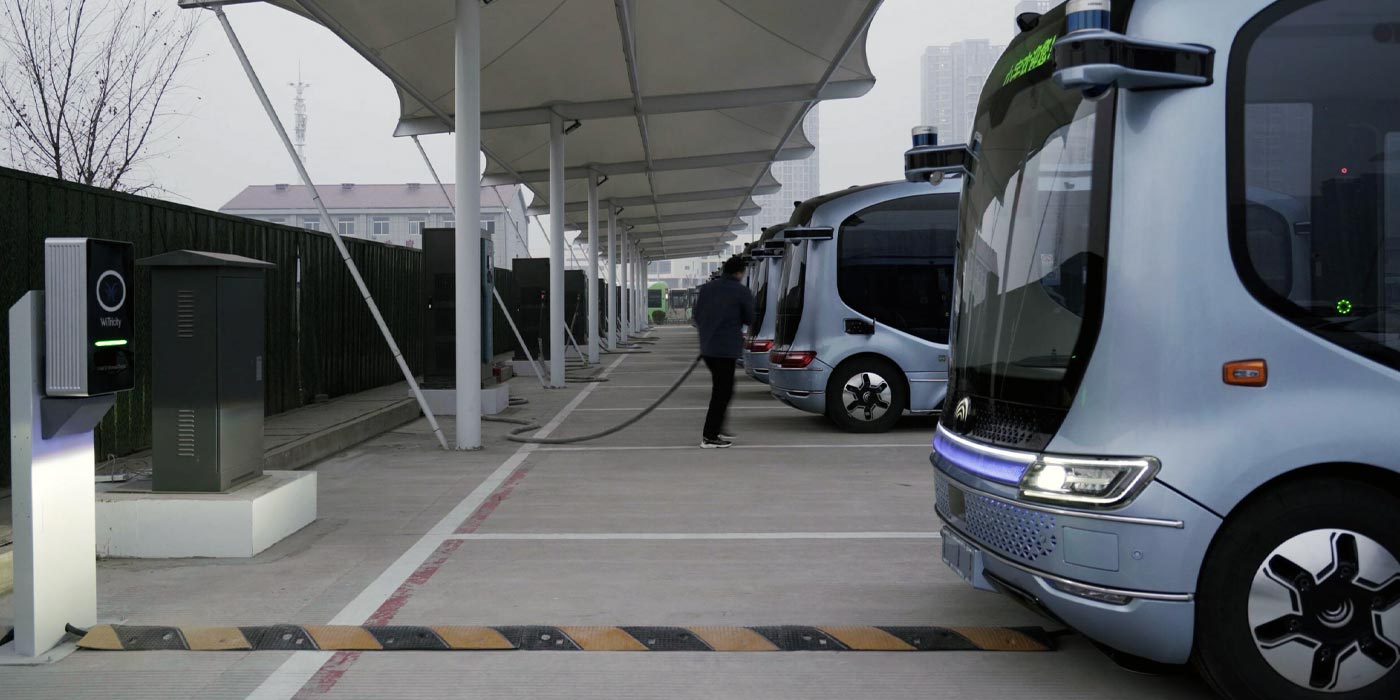Ponder this, non-EV owners: Would you accept an EV as your next vehicle if, no matter your budget, you knew you’d always have the range you needed without ever having to plug in to charge up?
If you ask Jeremy McCool, founder and CEO of HEVO, this promise will be the catalyst that will convert the masses to EV owners.
“The one thing that wireless does better than anything else in terms of accelerating EV adoption is that it can provide the ability for drivers to drive and charge at the same time. And this year… we will be demonstrating in the Detroit area highway speed tests with 200-kilowatt wireless dynamic charging. So an [electric] vehicle will be driving at highway speeds, collecting charge as it goes,” McCool says.
In this episode of The Amped EV Podcast, McCool talks us through reasons why fleets are switching to wireless EV charging, how wireless charging works and why tollways that charge your car while you’re driving might be the next evolution of U.S. driveable infrastructure.
Want more Amped EV podcast? Click here.
Here’s a transcript of the show:
David Sickels: Hello, and welcome back to the Amped EV podcast. My name is David Sickels. I am the editor for The Buzz.
Nadine Battah: And my name is Nadine Battah, and I’m the editor of TechShop. What’s up, David?
David Sickels: We have a really cool guest in here today. But before I introduce who it is, I want you to picture a scenario for me. Close your eyes. Imagine this. It is the not-so-distant future. You are driving in your EV.
Nadine Battah: Oh, nice.
David Sickels: You are on one of America’s highways. You are going coast to coast, and you don’t have to worry about charging.
Nadine Battah: Wow. Sounds like heaven.
David Sickels: Well, a little slice of heaven, anyway. The reason is that there happens to be wireless charging embedded into the road that you’re driving over top. So every few miles you’re going over this strip that is wirelessly charging your car as you are driving. What do you think about that?
Nadine Battah: Wow. That’s really cool. I’m excited to learn more about this.
David Sickels: Let’s get to the interview. We are talking with Jeremy McCool. He is the founder and CEO of a company called HEVO. Jeremy, welcome to the podcast. Thanks for joining us. Can you tell us a little bit about HEVO and why you think it’s important to be in the wireless charging space?
Jeremy McCool: Yeah, thank you for having me on. Wireless EV charging, as it’s already been doing for mobile phones, is going to do the same thing for cars. It’s going to make it seamless, easy, and simple to charge your car. Today so many people are reporting user experience problems. Well, this is the solution.
Also, because we’re working directly with fleets, they need wireless charging because they need to solve for how do they charge their vehicle effectively and efficiently every single day. And wireless charging just makes things much, much, much more efficient all around the board. So, lots to discuss here today, and looking forward to it.
David Sickels: Absolutely. I have spoken to fleets, and one of the reasons that some fleets cite as being a little hesitant to get into the EV space is because they’re worried that their driver’s going to come back, and they’ve got all these things going on, and maybe they forget to plug in, and then the next day all of a sudden their entire schedule is off because they don’t have the range that they thought they were going to have. So makes a lot of sense.
Jeremy McCool: No, you’re absolutely right. We hear from fleet managers all the time that they’re having drivers arrive back, forgetting to charge. They may have OSHA safety standard requirements, not having tethered cords laying around, that they have to think about now what are they going to do with all these cords. But also on top of that, we tend to forget that there are union labor requirements and restrictions. One of those things is there are unions out there that restrict people from being able to plug in those cars. Those drivers are not allowed to do that.
All this results in extra costs. What we see is that it can result in a $100,000 per year charging attendant for every 30 to 50 vehicles, maybe maximum 100 vehicles, of management. So there’s this extra cost, this extra burden. There are some key challenges there. We know from these fleets and fleet managers that wireless charging is going to give them their solution on how to electrify their fleet.
Nadine Battah: You make some really good points, Jeremy. Other than, of course, being wireless, what are some of the big differences between wired and wireless charging? For example, could wireless potentially charge an EV faster or charge more efficiently than wired charging?
Jeremy McCool: Wonderful question. In terms of efficiency, what we see right now is that wireless charging is somewhere around 90 to 95% efficiency from the grid to the battery. When you compare that to plugin charging, from the grid to the battery of the vehicle, you’re going to see something in the range of 91, 92%, and upwards of 96 to 97%. So we’re only off by somewhere around 1 to 2% maximum efficiency. And if you think about that from the point of view of the person that’s charging their car, what it means is that on a day-to-day usage case, they’re only going to see a cost difference there in a few pennies per day of cost. It’s not that unique or relevant at this point.
Also, in terms of power capability. You asked that question. We now have technology that can charge vehicles in the 300-plus kilowatt range. What that means is we would be able to charge a car roughly 1,000 miles per hour charged, which is exactly the max amount that you’re able to get, approximately, with any other fast-charging, supercharging kind of network. So the limitations at this point are really on the battery side of the technology.
The one thing that wireless does better than anything else in terms of accelerating EV adoption is that it can provide the ability for drivers to drive and charge at the same time. And this year, with our partnership with Oak Ridge National Labs, because HEVO is the commercial partner for ORNL, this year we will be demonstrating in the Detroit area highway speed tests with 200-kilowatt wireless dynamic charging. So a vehicle will be driving at highway speeds, collecting charge as it goes. It’ll be a short run just to showcase and demonstrate what we do. But from there, we do anticipate and expect that there will be future projects that will be announced that will then go forward with things like new vehicles being tested out on highway-speed tracks in other locations as well.
So we’re starting to channel toward an inevitable future, which is that everybody would be able to just drive. That is what we think it’s going to take to accelerate EV adoption at the mass adoption type of level. Early adopters, different story. They’re willing to deal with some of the core challenges and things that go on with technology adoption. Mass adopters, they will not.
David Sickels: That is really interesting. Now, just for clarity, when you say dynamic charging, that refers to when you are driving, you are also charging at the same time over whatever strip that is. Is that correct?
Jeremy McCool: Yeah, exactly. Imagine it like this. You’re driving on a tollway, and that tollway, for every five to eight miles, has a strip in it, and it’s a one-mile-long strip. While you’re traveling at highway speeds, 60, 70 miles per hour, you’re going to pick up an additional 8 to 10 miles of range. You quite literally would never have to stop to charge.
But, when we think about it from a major infrastructure point of view, obviously what I’m talking about here today with this dynamic in-road charging is a lot of infrastructure requirements. But say we took I-40 as an example, and you put one lane with wireless charging going from east to west and from west to east. The cost to do so would be less than a billion dollars. That is remarkable, because in order to do that same stretch with plugin charging, highway speed level supercharging DC fast chargers, you’re going to have to put in billions of dollars worth of charging equipment to do the same.
So, what we’re talking about here is not only efficiency around the time management of people not having to stop and charge, but the economic efficiency of being able to put in infrastructure while we’re in the midst of going through a massive infrastructure overhaul, and doing that the right way that it can accelerate EV adoption, and frankly accelerate renewable adoption too, because there’s no reason why those wireless-powered roads should not be powered by solar or wind or other forms of alternative energies.
David Sickels: Well, I think you’re right. That would certainly be a game-changer if range was no longer an issue because you essentially have infinite range. Can you tell me, for a layman like myself, how exactly is this charging the vehicle? Do you need to install hardware on your vehicle in order for it to work, or is there some software that goes into it? Or is it one of those things where it just knows, hey, this is a lithium-ion battery, it needs to get charged?
Jeremy McCool: Great question. At the top of that is, first, we know that there is a requirement to a vehicle integration side, right? Just like your phones or any other wireless charged devices, you must have a vehicle-side-ready device that can receive the power. So the primary pad that is a wireless pad, as you can imagine a souped-up version of a wireless pad for a mobile phone charger, to a degree like that. Just much more robust for infrastructure and great connectivity, certification, and all these things that we had to go through. We are UL certified. We are SAE qualified. Those are two designations for both the grid side, and both that and the vehicle side.
So, what I mean is that you will need to have a vehicle device. That can either be aftermarket retrofitted, which we typically don’t want to do because it starts to get into things like voided warranties, and people don’t want to, obviously, go that route, or it’s natively built in. Over the course of the last several months, we’ve announced a handful of partnerships with automakers such as Lightning eMotors and Stellantis that we are developing now technology that they will hopefully soon be able to start offering to their customers natively built-in.
Ultimately, that’s what everybody needs. Once you have wireless in the car, there’s no perception out there that if people have it, the availability of wireless, they won’t do wireless. They’re going to want to do wireless.
So, yes, to answer your question directly, you do need to have a piece of equipment in the car, another piece of equipment that’s charging the vehicle wirelessly with that souped-up version of a pad, kind of like a phone, and there is a software in between that communicates between both the vehicle side and the grid side, and also to the cloud so that we know that vehicle is charging at that location.
David Sickels: Very cool. In regard to that Stellantis partnership you mentioned, are you able to say at this time what model year vehicles you expect that to be entwined with?
Jeremy McCool: We do know that there’s going to be a handful of different platforms that we will model with. An example of that is Stellantis. But I would tell you also that there are a couple of other brands within the Stellantis family, which includes Peugeot and Fiat, that have gone through the form of electrification for different models of vehicles, and we’re working towards something there that could potentially play for people around the world.
I’m going to give you a user story. One of the biggest fleets in the world is actually located in the UK, and they happen to focus specifically on accessibility, or in other words, disabled drivers that have upper and lower mobility problems. Well, they have a requirement. They have to fully electrify their fleet in the next seven to 10 years by government requirements. Well, they can’t really do that reasonably, because people that are their drivers cannot pick up these cords. So they have to have wireless charging.
And, then there’s a subset within that that is only certain types of vehicles that they’re allowed to offer. So thankfully, within the Stellantis family of automotive, different vehicle platforms, there are a handful that would look like they could meet that mark.
So, yes, there are quite a few different opportunities that we’re working on with Stellantis, and some that will be hopefully announced very soon. But we’re very excited to have this partnership in place, and already working
David Sickels: That’s very cool.
Nadine Battah: Definitely sounds very exciting. Just to clarify, can virtually any EV be wirelessly charged using one of your wireless charging pads, or does it depend on the make and model of the vehicle?
Jeremy McCool: Great question. If we’re doing aftermarket retrofits, there are a few kinds of vehicles that we have been doing in the past. Again, that’s not our route going forward, because now we do have these automotive partnerships in place. Any electric car can be wirelessly enabled. And it’s not really that significant to go through that process in terms of development. Getting that vehicle readied up with everything connected to it, it’s quite literally a one-hour or less job if we know what we’re dealing with in terms of a retrofit.
However, we want to make sure that the vehicle is charging in the correct manner, and communicating in the correct manner. So that is where the development time takes place. That could be anywhere from weeks to months of work. We’ve had to go through processes where we had two weeks to integrate a brand-new vehicle platform. We’ve been able to do that in the past. So we can move fast, especially when an automaker needs us to, but typically you would see something in the range of a three-to-six-month development cycle before that vehicle is fully involved with a wireless charging system.
Nadine Battah: Very interesting. To piggyback off of that question, can a heavy-duty truck be wirelessly charged just as easily as a passenger car?
Jeremy McCool: It can. In fact, the majority of the vehicles that we’re dealing with today in our mix of fleet vehicles are going to be somewhere in the range of Class 2-plus to Class 4. Let me state what that is. Those are delivery vehicles and vans that you see roaming the streets anywhere around the world. It’s up to the size of a big box truck or a shuttle bus. So one of the first projects out the gate that HEVO has announced for 2023 is a program called the Clean Transit Accessibility Program, or CTAP, which is out of New York State. It’s been funded by the New York State Energy Research and Development Authority, also known as NYSERDA. And it’s also got additional financing and backing from major investment banks around the world.
What’s behind it? First is that it’s taking into account that there are hundreds of thousands of people that are using what is known as dollar vans to get around the outer borough areas of New York City every single day because they do not have accessibility to mass transit. As you could imagine, there are thousands of vehicles that are creating emissions issues in already emissions-dense zones. So we have a wonderful partnership with a company called Dollaride which is transitioning its fleet over to electric.
So the Dollaride team and HEVO, plus a few others, came together, won this proposal and this project from the State of New York, and we’re going to be going through a project to electrify about 100-plus shuttles with them that are also going to be wirelessly charging at dedicated locations around the outer borough area of the city.
So overnight they’re going to wirelessly charge, and during the daytime, these are hybrid charging locations. So we are offering both wired plug-in and wireless together in one solution. So during the daytime people will be able to plug in if they have a regular vehicle, pull up and get a hamburger and fries or something like that at that location, and then at nighttime, those vehicles will charge cars overnight.
David Sickels: Very, very interesting. If I am a fleet owner, and let’s say I decide that this is the solution for me and I want to install maybe half a dozen of your solution, how do you help me determine how many I might need, and how many of my trucks should be retrofitted with this? Do you help us figure out, okay, you need to work this out six months ahead of time? How does that whole process work?
Jeremy McCool: It’s a great question. I appreciate that one because it’s direct from what we’re working through right now. Project planning and management is part of the process of this. HEVO has three different types of customers and partnerships in place to be able to do projects around the world. Those are, first and foremost, automakers. Those are partners that we have developed relationships with and are in the process of putting our wireless charging systems and solutions onto their vehicles.
Secondly is the network providers, existing EV charging station developers and network providers that are already out there. And then thirdly, the actual channel partners that are responsible for the installation, operations, and maintenance, or the OEM. So that third channel, the channel partners that are responsible for the installation, operations, and maintenance, they go out, they do an assessment with that fleet customer or whoever that customer might be, understand what their charging needs are going to be, and then from that process, we go through a whole planning of that project together to ensure that delivery times and the quality of the product and all of those things are all there for those customers.
Now, I would add one more last wrinkle to this point, which is that we have this availability around the work. We have channel partners and existing network partners in the UK, Europe, Australia, Korea, and we’re starting to expand into South America over the course of the next 12 to 18 months as well. So we are not just an American-focused company. That’s frankly what we have been focused on for the last few years. Over the last year, we’ve been able to bring on companies and organizations and partners from around the world.
David Sickels: Congratulations. That’s huge.
Nadine Battah: Very nice.
Jeremy McCool: Thank you for that.
Nadine Battah: Now, when it comes to audiences, which of your audiences has been most receptive to your wireless charging pads? Your consumers, fleets, municipalities?
Jeremy McCool: First and foremost, HEVO started because of fleet-orientated type of business models. I was meeting with people at FreshDirect, Frito-Lay, Pepsi-Cola. These kinds of organizations, even back in 2009, and 2010 had started to switch over to some form of electric vehicle delivery systems. And the problem they were already having was plugin charging. They either had drivers not remembering to plugin charge, or accidentally backing over the cords and destroying those cords, or some other universal issue that all fleets have experienced as they’ve tried to electrify their fleets.
So fleets have been by far and large the easiest answer in terms of accelerating the adoption of wireless charging. That’s where we see the majority of our customers today. So when we think of our customers, end users, AKA off-takers, what we say that is, is that’s the fleet.
Now, consumers have been reaching out to us for a decade asking how they can get their hands on it, and we’ve gone through a process in the last year and some change of evaluating what that could be through a couple of different means. One is, is that HEVO has been very successful with crowdfunding. We’ve raised almost $5 million in the last year or so off of multiple crowdfunding platforms, that being Republic and Wefunder. And we currently have actually an existing crowdfunding platform that’s operational today that people can invest into on Wefunder.
But what’s really important to that, not only is it the funding side, the level of testimony that we’re getting from the retail investor, people that drive electric cars today that say, “I have an electric car, this is what I need, this is what’s missing, and I need it now.” So they invest, quite literally, with their money, and then they’re helping us to understand what is really behind it. The testimonies have been remarkable. Absolutely remarkable. I would say every third or fourth investment that we get, we get an incredible story or some kind of testimony about why this matters to that person, because they are possibly either an electric vehicle driver, or they want to be, and they need the wireless charging. So that’s thousands of investors and thousands of people that now have given us those kinds of testimonies. We’re thankful and grateful to them all for all those reasons.
So we’ve been being reached out to. We’ve been going to trade shows and talking with customers. And without a doubt, they’ve made their voice very clear to us. They want wireless charging, and they want it now. And they verbatim have been stating, “This is what I need to go electric.” They don’t want to touch the cord. They don’t want to pull off to the side at a Supercharger or some kind of DC fast charger off the side of a highway when it’s pouring rain outside and connect major voltage to their car. There are a lot of problems with that type of interaction. So to answer the question directly, consumers want it today, and fleets have to have it right now.
David Sickels: Gotcha, gotcha. You mentioned the rain. How does your solution change how things might be perceived in terms of weather? How well does this kind of installation hold up to torrential rain or things like that as compared to maybe your standard level two charging station you might find out on the road?
Jeremy McCool: We’ve had to go through what is known as underwriters laboratory testing certification, or UL certification. It is very broad in stroke and also very deep in responsibility and capability of the technology. So we’ve had to go through significant environmental testing and certification for rain, snow, direct pressure, contact, also not to mention salt, lubricants, and all kinds of different liquids and solvents, just like any other piece of hardware would have to go through any kind of testing.
So these highly protected systems are also hermetic. That means that they are waterproofed to a requirement that must be met and beyond. We’ve gone through all kinds of different challenges in terms of project deployments. Today, we have systems out in professional projects with some of our partners around the world where it’s raining 300 days out of the year, and these systems are constantly underwater because they’re in high flood areas to a degree. So we’ve had to witness that firsthand many, many years and iterating on that technology to make sure that it meets the requirements, and to get to a place where we can, without a doubt, tell our customers, “This is a highly safe technology.”
Even if you’re charging and there’s snow on it or ice on it or rain is out there, there is no voltage. There’s nothing that’s being penetrated through the system. This is all electromagnetic. It’s charging through frequency, just like any other kind of frequency. But this frequency happens to provide power wirelessly.
David Sickels: Got it, got it. So if there’s half an inch, an inch of snow on top of it, does that affect the efficiency at all in any way?
Jeremy McCool: No, because alternating current is the methodology of the transfer. There’s alternating that is on every single major line of electricity or even your little plugs. The difference in this is that we coiled it up into a certain type of coil size and geometry that helps it to have exceptional high efficiency that penetrates through any form of natural substance, with one exception. If you put a giant piece of metal on it, it’s not going to transfer, because it’s blocking it. Just like you’d imagine anything that would block another frequency-enabling object like this.
David Sickels: Totally makes sense.
Jeremy McCool: So without containerizing it and creating a faraday kind of solution, or a situation, I should say, there’s nothing there that would block it to charge through any kind of element, whatever it might be, ice, snow, water, mud, with the same level of efficiency.
David Sickels: Sure, sure. And then how about maintenance? If I’m a fleet and I put a bunch of these in where my vehicles are parked every night, how do you expect me to maintain them throughout the year?
Jeremy McCool: Well, that’s the great news about wireless. There’s not a lot of maintenance to the story because these pads, first and foremost, are optional to how you actually deploy and install them. You can either do a surface mount, you can do a flush mount like a manhole cover, or you can actually put it under rock, gravel, sand, even tarmac and cement in roadways.
So you’ve got different options for how you implement it, and the requirement there is very simple. Don’t take it off the street with a snowplow or something like that. But minus something very destructive like that, this is equipment that doesn’t really need to be maintenanced every single year.
The actual problem with the technology is that it may last much longer than the vehicle does. So the reality is, is that this has been built with the capability to have 150,000 hours of usage. That’s a lot of charging before you would ever need to see potential replacements of any form of the product. And even in that case, it may just be a few parts that need to be replaced. The majority of the equipment, the majority of the parts in this, everything is off the shelf that we have designed and developed together, but the majority of it is polymer, polycarb, aluminum, and copper wiring with some ferromagnetic material that helps to create a form beam to have high efficiency.
These are very natural products that are easily found around the world, so supply chain issues and things that people have had to suffer through in the past many years, these aren’t those kinds of products that have those problems.
David Sickels: Very interesting. Jeremy, thank you so much for joining us today. This has been a pleasure. This is a really, really cool technology that you are really pushing forth here. I really look forward to seeing where you go with it.
Jeremy McCool: Hey, thank you so much for your time today. It’s been great to be on here with you both. Thank you very much.
David Sickels: Absolutely. Take care.
Jeremy McCool: Take care. Bye.
David Sickels: That was a lot to take in. But a lot of exciting stuff.
Nadine Battah: Definitely. Really interesting stuff. I feel like this is going to get a lot of people excited and interested.
David Sickels: I mean, he said he had, what, 5 million in crowdfunding from consumers alone. We’re not even talking about the fleets here.
Nadine Battah: Right. Just the fact that it’s not a lot of maintenance required, it’s seamless, fast, easy charging, I think is a turn-on for a lot of people.
David Sickels: Yeah, yeah, yeah. And he’s got those partnerships that he mentioned with Stellantis, and trying to work with fleets and these buses and things like that. That’s really exciting for him. And then of course the dynamic wireless charging. Just imagine that being something where, whether you’re a consumer or you’re a fleet, you don’t have to worry about your range in your EV.
Nadine Battah: Yeah. That was insane to me. I thought that was really cool. I think it’s definitely going to be something big in the future because I think charging is one of the biggest deterrents for people in purchasing an EV. So I think this was a great conversation, and definitely something that these consumers have something to look forward to.
David Sickels: Yeah, absolutely. I have a lot of questions that I don’t know that can be answered right now. Like for example, let’s say we’re installing these all throughout America’s highways, or on one particular highway, whatever it might be. How does that work as far as who’s getting the bill for that? Is it the municipality, or as the charging is happening? There are a lot of things in there that need to be worked out. But that being said, it could be a very interesting future for EV owners if this kind of thing should take off.
Nadine Battah: Definitely, definitely. Thanks for having me on this show. I think this conversation today was really exciting. I love being on the show. It’s a lot of fun.
David Sickels: Hey, you can join any time, Nadine. I’m amped to have you here, as always.






